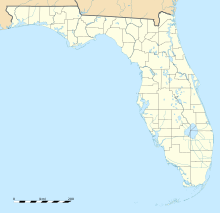Florida Holocaust Museum
 |
|
| Established | 1992 |
|---|---|
| Location | St. Petersburg, Florida |
| Coordinates | 27°46′14″N 82°38′26″W / 27.770529°N 82.640622°WCoordinates: 27°46′14″N 82°38′26″W / 27.770529°N 82.640622°W |
| Type | Holocaust museum |
| Website | www |
The Florida Holocaust Museum is a Holocaust museum located at 55 Fifth Street South in St. Petersburg, Florida. Formerly known as the Holocaust Center, the museum officially changed to its current name in 1999. Founded in 1992, it moved to its current location in 1998. It is one of the largest Holocaust museums in the United States. It was founded by Walter and Edith Lobenberg both of whom were German Jews who escaped persecution in Nazi Germany by immigrating to the United States.
The Florida Holocaust Museum was founded by Walter Lobenberg and his wife Edith Lobenberg in 1992. Both of them had been born in Germany and had escaped Nazi persecution. Walter Lobenberg was born in Wächtersbach, Germany but due to Nazi prosecution of his father and the subsequent difficulties in running the family store, the Lobenberg family moved to Frankfurt in 1936. It was in Frankfurt in 1938 that the Lobenberg Family experience Kristallnacht, with Walter narrowly escaping physical harm and being forced to hide. Eventually through the support of an Aunt already living in the United States Walter Lobenberg was able to immigrate successfully and eventually moved to Chicago. He then served in the United States Army for the duration of the Second World War after being drafted in 1942.
After completing his time in the United States Military, Walter Lobenberg would go on to meet Edith Lobenberg leading to their marriage in 1948.
The Museum was founded by Walter and Edith Lobenberg in 1992. It was founded with the idea of “teaching the members of all races and cultures the inherent worth and dignity of human life in order to prevent future genocides”. The Holocaust Museum was originally founded as the Holocaust Center in a space that was rented from Jewish Community Center of Pinellas County. It was here that the Holocaust Center would host its first exhibit on, ‘Anne Frank in the World’. This would prove to be a very successful exhibit able to attract 24,000 visitors within the first month. As the Center proved popular it began to run teaching seminars, lectures, and commemorative events in which visitors could participate. Additionally the Center began to connect with the local educational system; schools in an eight county area surrounding Tampa Bay were provided with study guides, teacher training programs and presentations by Center staff and Holocaust survivors.
By 1996 the Holocaust Center had grown to such a point that a larger space was needed and thus the Board of Directors voted to buy and renovate a new building for the Museum. This new building, a former bank, was 27,000 square feet in comparison to the 4000 square feet in the previous space. The building was to be renovated by 1998. The Architect chosen for this task was the Israeli-born Nick Benjacob. He would produce the distinctive shape of the new building which prominently featured triangles, explaining that “The era of World War II is so depressing that I did not want to do anything with either circles or squares, because they are whole shapes. I wanted a broken shape. A triangle is a suppressing shape, it is a hard shape, and I wanted to design a feeling for the visitors before they even entered the museum".
...
Wikipedia

